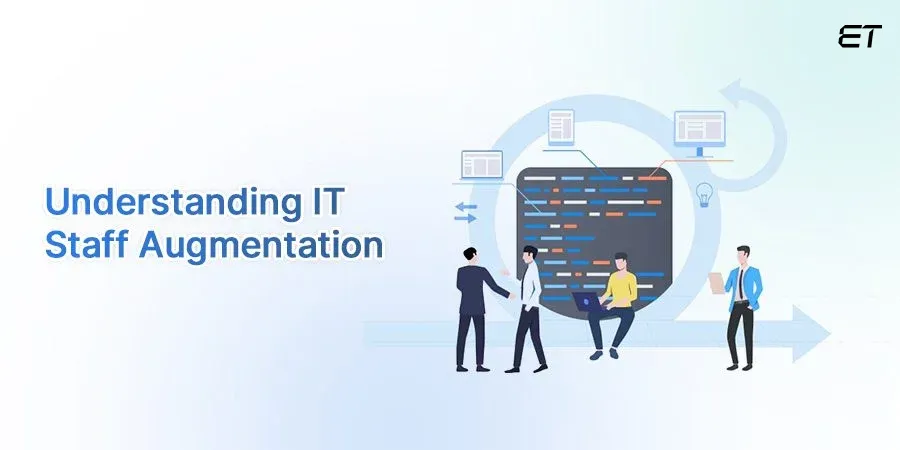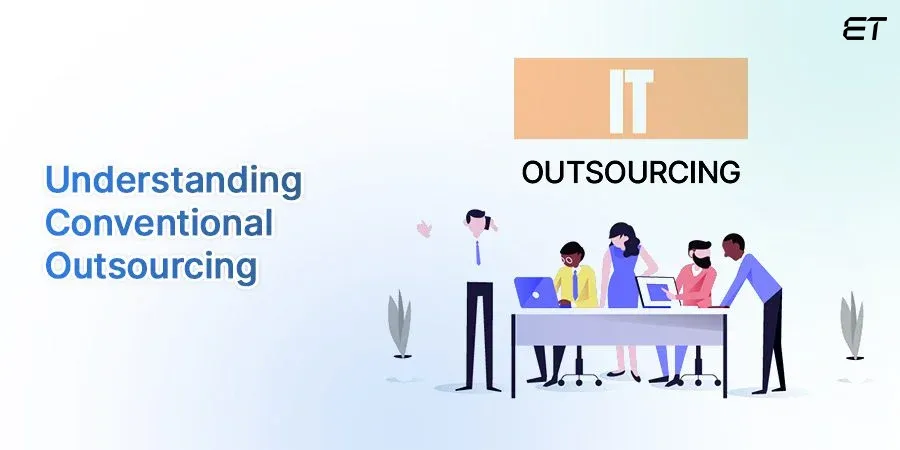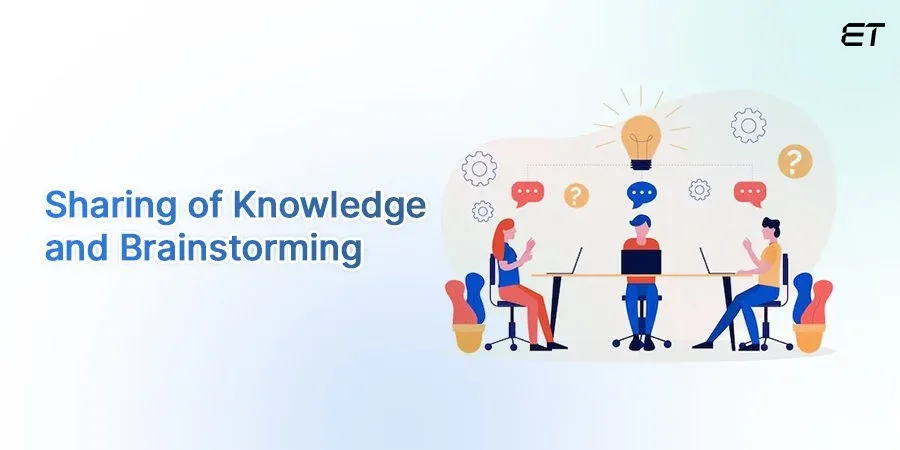Let’s face it – covering all the facets of a software development project is challenging. That’s why most companies choose the outsourcing option.
Lately, global spending on IT services surpassed a staggering USD 1.28 billion mark. So, it’s no doubt that the budget for acquiring specialized IT services is increasing every year.
If you want the assistance of skilled developers, the choice of engagement models becomes crucial. In fact, the comparison of staff augmentation vs outsourcing keeps popping up from time to time.
So, to make the right decision and choose a suitable outsourcing option, scroll ahead and understand the differences between the two.
A Quick Look at IT Staff Augmentation
In simple terms, staff augmentation implies hiring temporary employees to complete your project and bridge the existing skill gap.
Here is a simple explanation of this service:
- You want to complete a specific project
- For this purpose, you analyze the existing team
- You realize that certain professionals are not present in the current team
- After a detailed assessment, you approach a team augmentation vendor
- This vendor connects you with skilled professionals as per the requirement
- You hire these employees on a project basis for a fixed duration
Through IT staff augmentation, you accelerate the development speed and build an augmented team of proficient experts.
Pros and Cons of IT Staff Augmentation
Staff augmentation can be a useful for businesses, but it’s not without its drawbacks. Here’s a rundown of the pros and cons to consider:
Pros
- Access to Expertise: Augmentation brings in specialists for specific projects or fill skill gaps in your current team
- Scalability: You can easily adjust your team size up or down as needed. This is particularly helpful for companies with fluctuating workloads or unexpected projects
- Cost-Effectiveness: With this model, it is possible to avoid the costs associated with permanent hires, such as salaries, benefits, and recruitment fees
- Faster Time to Market: You can get projects started quickly by bringing on pre-vetted talent without the lengthy traditional hiring process
Cons
- Integration Challenges: It is crucial to ensure effective communication and collaboration between augmented staff and your existing team
- Potential for Disruption: Introducing new team members can disrupt team dynamics and workflows
- Limited Knowledge of Company Culture: Augmented staff may not have the same understanding of your company culture and processes as permanent employees
- Loss of Intellectual Property: You need to be mindful of sensitive information when working with temporary staff.
By carefully weighing the pros and cons, you can decide if staff augmentation is the right strategy for your specific needs.
A Quick Look at Project Outsourcing
To know the details of staff augmentation vs IT outsourcing, it is crucial to understand the fundamentals of both strategies.
In the former, you hire temporary staff on a short-term basis. However, in the latter, you outsource a project and give direct control over some aspects of your business.
The reliability, previous experience, and portfolio of an outsourcing company have a considerable influence on the output. Now that you know the basics of both strategies, scroll below to note the comparison of staff augmentation vs outsourcing.
Pros and Cons of Traditional Outsourcing
IT outsourcing can be a double-edged sword. Here’s a breakdown of the advantages and disadvantages to consider:
Pros
- Cost Savings: Outsourcing can be cheaper than hiring and managing a full-time IT staff, especially when labor costs are lower in the outsourcing destination
- Access to a Wider Talent Pool: You’re not limited to local talent. You can tap into a global pool of IT professionals with the specific skills you need
- Improved Focus: It is possible to free up your internal IT team to focus on core business initiatives instead of everyday maintenance tasks
- Potential for Increased Efficiency: Experienced outsourcing providers can have streamlined processes and expertise that can lead to faster turnaround times and better results
Cons
- Loss of Control: In outsourcing, you hand over some control of your IT infrastructure and data to a third party. This can be a concern for companies with sensitive information
- Communication Challenges: Time zone differences, language barriers, and cultural differences can make communication difficult and lead to misunderstandings
- Security Risks: Data breaches can be a major concern when outsourcing IT. It’s crucial to choose a provider with a strong security track record
- Hidden Costs: While upfront costs may be lower, there can be hidden fees for things like project management, training, and communication
By carefully weighing the pros and cons and taking steps to mitigate the risks, traditional IT outsourcing can be a strategic way to improve your IT capabilities and free up resources for core business functions.
Staff Augmentation vs Project Outsourcing: Head-to-head Comparison
Here is a point-wise analysis of both sourcing strategies. Analyze each point to decide which tactic is suitable for your business at a certain junction.
1. Structure of Working
In IT staff augmentation, the augmented staff becomes a part of our in-house team. Be it on-site or remote, these professionals share ideas and work as a cohesive unit.
On the contrary, project outsourcing has an independent structure. The vendor’s team works on completing your tasks without the need to collaborate with your staff.
Which Model to Choose?
Staff augmentation vs outsourcing: Who wins?
This comparative point ends up in a tie. In some cases, you would want skilled professionals to share ideas and work as part of your team. On the other hand, you might have less time to manage a group of employees and prefer specialized services.
So, the choice of a particular service varies as per your requirements.
2. The Knowledge Sharing Aspect
IT staff augmentation is best suited for brainstorming and knowledge-sharing sessions. Why?
In this module, you hire temporary workers who are skilled in their respective fields. As they become part of your team, exchanging ideas and sharing vital knowledge on technical and non-technical topics is possible.
On the contrary, project outsourcing does not involve knowledge sharing. An IT organization can utilize skilled resources to complete your project. However, they will not (in most cases) share the tips and tricks utilized during the development process.
Which Model to Choose?
Staff augmentation vs outsourcing: What to prefer?
IT staff augmentation can be a good choice if your primary goal is to bolster your existing team’s knowledge.
However, choosing this module is dependent on the following factors:
- Type of professional
- Nature of project
- Work culture
You should foster a collaborative environment to make the best utilization of team augmentation.
3. The Onboarding Criteria
In staff augmentation, the onboarding activity is quick. Vendors have a vast pool of professionals who can work on their projects as per clients’ requirements.
On the other hand, IT outsourcing requires adequate time as the project requirements go through multiple stages before initialization. Further, completing the documentation and finalizing the end quote requires discussions and scrutiny.
Which Model to Choose?
Staff augmentation vs project outsourcing: Who wins?
IT staff augmentation is the clear-cut winner in this aspect. The best team augmentation vendors have the required resources easily accessible. So, you can hire temporary staff members after posting your project requirements.
4. Work Culture and Compatibility
In IT staff augmentation, the new hires can take time to adapt to your organization’s setup. You must create a collaborative work environment, focus on keeping employee morale high, and simultaneously protect confidential data.
In the case of IT outsourcing, there is no need to worry about the compatibility aspect. The professionals of your vendor’s company work from their workplace. So, there is no need to interact with every member who is contributing to completing your project.
Which Model to Choose?
Staff augmentation vs outsourcing: What to prefer?
In this case, the comparison leads to a tie. If your organization has room to accommodate new temporary employees, there is no need to fret over compatibility.
However, if you do not have the time to welcome new members and want to finish a project quickly, choose IT outsourcing. Remember, this service can prove comparatively more costly than team augmentation.
5. Formal Relationship with the Vendor
IT staff augmentation mainly focuses on the client interacting with the augmented staff. Once you choose temporary employees, contacting the vendor is not necessary. Your communication will be limited to financial contracts, tenure of work, and non-disclosure agreements.
On the other hand, outsourcing a project requires thorough communication with the vendor. Since you are in constant touch with the IT partner, it is possible to build a fruitful long-term association.
Which Model to Choose?
Staff augmentation vs project outsourcing: Who wins here?
Outsourcing is a better strategy if you want to partner with a reliable software development vendor or similar agency. In the B2B market, connections play a vital role in building brand awareness.
So, choosing the outsourcing module (if you have a decent budget) can prove to be a good decision.
6. The Costing Factor
The key costing differences between staff augmentation and traditional IT outsourcing focus on control and flexibility versus potential cost savings.
Staff Augmentation is generally more expensive. You typically pay an hourly or daily rate for the augmented staff member’s time. This can be more expensive than outsourcing, especially for long-term projects. However, it is more flexible as you only pay for the time and expertise you need. If the project scope changes or the need for the augmented staff diminishes, you can easily adjust your costs.
Expected cost: USD 30 – USD 100 per hour (subjective and depends on the augmentation company and location)
In case of traditional IT outsourcing you can find providers that may offer lower hourly rates, especially if labor costs are lower in the outsourcing destination. Still, you should be wary of fees for project management, training, communication, or unexpected changes in scope.
Expected cost: USD 20 – USD 70 per hour (subjective and depends on the vendor, experience, location, and market conditions).
Which Model to Choose?
So, who wins in this staff augmentation vs outsourcing comparison point?
Staff augmentation offers more control and flexibility in terms of costs, but may be more expensive overall. On the other hand, traditional IT outsourcing can offer lower upfront costs, but you need to be mindful of potential hidden fees and lack of flexibility.
Staff Augmentation vs Outsourcing: Major Differences
After analyzing the five main pointers that relate to both team augmentation and outsourcing, it is time to compare the two based on miscellaneous factors.
Refer to the table below to get an overview of the staff augmentation vs IT outsourcing comparison.
Staff augmentation vs outsourcing
| Sr. No. | Parameter | IT Staff Augmentation | Project Outsourcing |
| 1 | Training cost | Less, but is the responsibility of your company | Not applicable. The vendor handles the training requirements |
| 2 | Level of control | High | Low |
| 3 | Cost-effectiveness | High | Subjective |
| 4 | Main purpose | To bridge skill gaps | To outsource entire projects |
| 5 | Team size | Variable | Fixed (As per the decision of the vendor) |
Bonus Section: Our Experiences with Both the Project Development Strategies
At eLuminous Technologies, we offer various engagement models to meet the requirements of businesses. While comparing staff augmentation vs outsourcing, we thought that it would be better to offer you practical examples of the two strategies.
So, in this section, we put forth one small case study and share our insights. This way, you can make the best decision in choosing a pertinent outsourcing strategy.
IT Staff Augmentation
We helped an exclusive US-based e-commerce shop with our dedicated team model.
Here are the insights of the service:
- The client wanted to increase conversions by enhancing aspects like UI and UX
- After analyzing the requirements, we suggested a team of dedicated and skilled members
Details of the team:
- Number of professionals: 8
- Profiles: UI Designer, Frontend and Backend Developers, QA Specialist
- Years of association: 5+
- Number of hours worked: 8000+
These temporary professionals worked on four applications through staff augmentation and used over nine technologies.
Result:
Through our staff augmentation service, we helped the client achieve USD 10 million in profits. During this period, we noticed that the customized choice of temporary professionals saved time and helped bridge the talent gap at the client’s organization.
IT Project Outsourcing
We offered a UK-based pharmaceutical company our outsourcing service on the web-centric legacy system. The client didn’t have a unique e-commerce website.
- Vital functionality like multi-lingual support and proper showcasing of FDA products were missing
- The system wasn’t scalable and lacked the reach for exploring new business territories
Our solution comprised of using Magento enterprise solution that had a coverage of the following facets:
- Responsive design
- Local content
- Centralized administration
Result:
Our team was successful in achieving a rollout rate of under 90 days (about three months). The client’s business expansion was in three countries – Canada, the USA, and France. Overall, during this project, we were able to attain a brisk pace of development and deployment.
So, the staff augmentation vs outsourcing debate can hover around two main factors:
- IT staff augmentation: Customization
- Project outsourcing: Quick project deployment
In our experience, each model has its core benefit. So, choose any service according to your project demand and company’s requirements.
Staff Augmentation vs Outsourcing: Which One Is Better for Your Business?
Staff augmentation vs outsourcing is a standard comparison for businesses. Companies employ temporary staff members in the former, while in the latter, they assign a complete project to a vendor.
If you want the benefits of knowledge sharing and quick onboarding, prefer IT staff augmentation. On the contrary, choose to outsource if you intend to build a long-term association with the vendor and develop projects at a comparatively brisk pace.
In any case, gauging your requirements and connecting with a dependable software partner is crucial. To receive professional guidance on both these modules, you can always contact eLuminous Technologies. So, choose the most suitable outsourcing strategy wisely!
Frequently Asked Questions
1. What are some of the well-known staffing models in the IT industry?
Some popular staffing models in the IT sector are hiring full-time employees, IT staff augmentation, outsourcing, consulting, and choosing a hybrid model. Amongst all these options, the staff augmentation vs outsourcing debate is very popular amongst companies.
2. What are some famous staff augmentation companies in India?
HCL Technologies, TCS, eLuminous Technologies, Applify, and Supersourcing are prominent team augmentation companies. Before connecting with any similar company, check the portfolio and case studies to evaluate proficiency.
3. What are some significant advantages of IT outsourcing?
Some main benefits of project outsourcing are fast turnaround time, workload distribution, cost savings, and access to specialized talent. You can contact team eLuminous to experience all these pros at reasonable costs.
4. What are the main pros of IT staff augmentation?
Through team augmentation, you can connect with dedicated experts and hire them temporarily. Notably, you don’t need to conduct interviews and perform thorough evaluations of such professionals. The IT vendor offering these services takes care of the talent-sourcing facet.
5. What is the difference between staff augmentation and outsourcing a dedicated team?
Simply put, staff augmentation involves adding temporary or contract-based employees to your existing team. On the other hand, outsourcing a dedicated team means hiring an external company to provide a complete group of professionals for a specific project or task.













